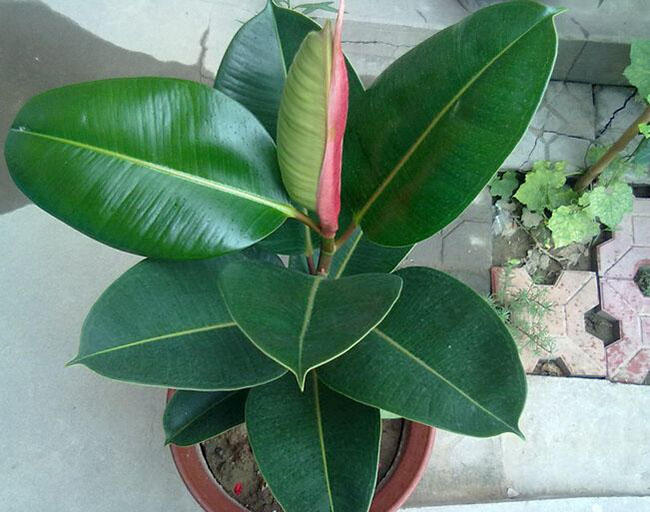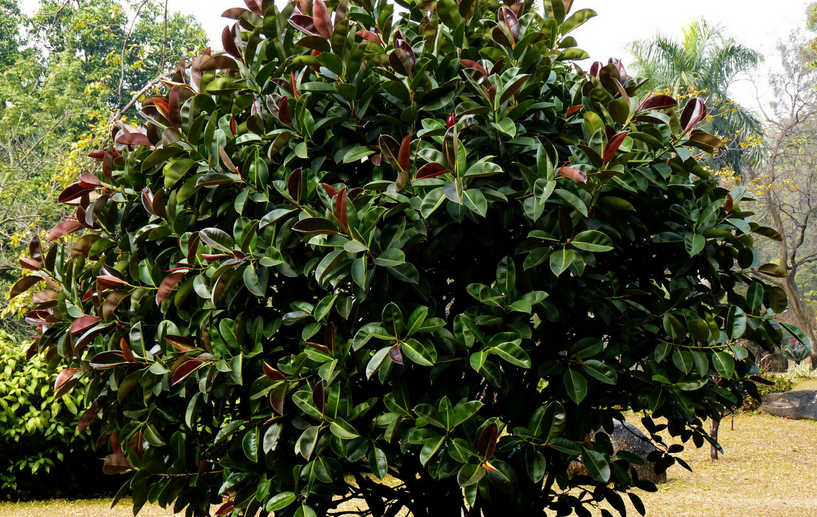How to breed rubber trees
Rubber trees are often propagated by cutting. Cuttings can be combined with pruning in summer, and it is best to select biennial semi-lignified middle branches. The most suitable temperature for rooting is about 30 ℃ in daytime and 15 ℃ at night. The cuttings can take root in about 20 days, and the survival rate can reach more than 90%. The length of cuttings is better to keep 3 buds, cut off the bottom leaves, and tie the upper two leaves with plastic rope to reduce leaf evaporation. It should be sealed with plaster or plant ash immediately after cutting, so as to prevent the flow of too much milk from the cut and affect the survival. Keep the soil moist after insertion, but do not accumulate water, often sprinkle water to the ground to increase air humidity, and do a good job of shading.
In addition, cutting can also be carried out in winter. The branches cut off with the new plants that survived in the same year were cut indoors before and after New Year's Day, kept at least 18 ℃, rooting in 2 months, and the survival rate of one-year-old twigs was about 60%.
Rubber trees can also be watered, in mid-late May. Select one-year-old top branches as cuttings, 6-10 nodes as 1 branch, cut off about 1 cm below the last leaf node, remove the following two leaves, place the cuttings in the shade for 1-2 days, cut the cut into a horseshoe shape with a sterilized blade, soak in 5% sugar water for 2-3 days, and then soak in clean water. The container should be shaded to facilitate the production of white tumors as soon as possible. Change the water once every 3 days to prevent the cuttings from rotting.
The container can be directly placed on the sunny windowsill, which is conducive to photosynthesis, accelerate the differentiation of the root plasma of branches, and form a white tumor as soon as possible. when the white tumor grows in the immersed part of the cuttings, the cuttings can be taken out of the water and inserted in the culture soil mixed with the same amount of rotten leaf soil, plain soil and sandy soil. the cutting depth is 3-5 cm, and the basin soil is often kept moist for about 20 days.
How to propagate rubber trees by cutting?
Rubber trees can survive only in high temperature environment, and should maintain a steady soil temperature, and the cutting survival rate is the highest from late May to mid-June. The primary tender wood cuttings are easy to rot, the old wood cuttings are not easy to produce callus, and it is difficult to root. Some branchlets are often sprouted from hidden buds on the large lateral branches of perennial plants, and their growth rate is slow, the internodes are short and have terminal buds, and the tissue is more abundant. Cutting them directly from the cortex close to the mother branch at the base has a high survival rate and forms faster because of the terminal buds.
When pruning rubber trees, many long branches are cut off every year, which can be used for cutting. First cut off the tender tip of the long branch, then press 3 sections to disconnect, and immediately seal the cut with plant ash to prevent milk overflow. At the same time, cut off the lower leaf, keep a leaf at the apex, or roll it into a tube and tie it with a string, or cut it off. The depth of the soil is 3-4 cm, and it is easy to rot if it is too deep. Due to the shallow insertion, the leaf left behind is relatively heavy, and the cuttings are easy to lodge, so it is best to insert a Reed pole to tie up and support.
How to propagate rubber trees under high pressure
Breeding rubber trees under high pressure has a remarkable advantage, that is, it is easy to succeed. Here is a brief introduction to the specific operation of reproduction by this method.
The propagation of rubber trees by high pressure can be carried out in both spring and summer. Prepare clay, string and plastic film before operation. Then select the branches on the mother plant of the rubber tree that are ready to be used as reproductive material. The more suitable branches should be more than 30 cm long, and the basal epidermis should be Lignified, that is, the branches whose basal epidermis are brown rather than green should be selected as breeding materials.
Measure down from the top of the selected branch, pick the leaves about 20 centimeters, and then peel off the bark here with a sharp knife to peel off a circle about 1 centimeter wide, and the depth is appropriate to see ballast. After the leaves are removed and the skin is peeled, the wound will flow as sticky liquid as milk, which can be wiped off with toilet paper. Then hold a ball of watered clay the size of a fist in the place where the branch is peeled off, wrap the plastic film tightly on the clay ball, and tie the upper and lower ends with string.
Put the mother plant of the rubber tree in a basin and put it in a place where there is plenty of sunlight for normal management. after a period of time, you have to use a syringe to pour some water into the dry soil ball. After about 6 to 8 weeks, more new roots can grow when the branches of the rubber tree are peeled off. At this time, you can use sharp shears to cut off the branches of the rubber tree that have already taken root, carefully remove the binding material, and plant it into a flowerpot filled with plain sand. Keep it in a place without direct sunlight for about half a month.
Often spray water to moisturize, and then gradually change to normal watering, and let it slowly accept direct sunlight. Six weeks after the new rubber tree is planted in a flowerpot, you can start applying some thin liquid fertilizer to it. At this time, you can use the new rubber tree that has adapted to the external environment by high-pressure breeding to decorate the environment or give gifts to relatives and friends.
- Prev

High pressure and Cuttage Propagation of Rubber trees
High branch crimping, also known as high pressure, air crimping, is a method of striping reproduction. Except for rubber trees, flowers such as Magnolia, Milan, rose, rhododendron, camellia, goose palm wood, weeping banyan, Zhu banana, variable leaf wood and other flowers can be propagated under high pressure.
- Next

How to propagate rubber trees?
Rubber tree only in high temperature environment can survive cuttings, and should maintain a constant soil temperature, late May to mid-June cuttings survival rate is the highest. The young twigs are easy to rot after cutting, and the old twigs are difficult to produce callus after cutting, so it is difficult to root.
Related
- Fuxing push coffee new agricultural production and marketing class: lack of small-scale processing plants
- Jujube rice field leisure farm deep ploughing Yilan for five years to create a space for organic food and play
- Nongyu Farm-A trial of organic papaya for brave women with advanced technology
- Four points for attention in the prevention and control of diseases and insect pests of edible fungi
- How to add nutrient solution to Edible Fungi
- Is there any good way to control edible fungus mites?
- Open Inoculation Technology of Edible Fungi
- Is there any clever way to use fertilizer for edible fungus in winter?
- What agents are used to kill the pathogens of edible fungi in the mushroom shed?
- Rapid drying of Edible Fungi

